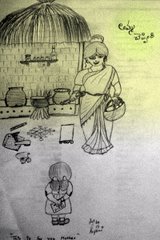Chinese aaku Pachadi/ Chinese Box-thorn Chutney
Set 1:
Red chillies - 25 no.
Coriander seeds - 2 tbsp
Urad dhal - 1 tbsp
Sesame seeds - 1 and 1/2 tsp
Cumin seeds - 1/4 tsp
*Fry these in little oil and powder in mixie.
Set 2:
Chinese aaku - 1 bunch (Pluck the leaves alone, wash well. Keep it on towel to dry out little)
Tamarind - lemon size (add enough water, until immersed. Microwave for 2 mins, cool, squeeze the pulp)
Salt as required
Oil - 2 tbsp
*Heat Oil in a deep pan and fry the leaves till it shrinks. Add tamarind juice and cook it until it becomes thick. Keep aside until cools down.
*Transfer this to the above mixie jar and add salt to taste, grind this into paste. Check for tartness and salt. Remove the grinded paste into a tiffin box.
Set 3 (seasoning):
Oil - 2 tbsp
Mustard seeds - 1 tsp
Red chillies - 4 no. (split them)
Asafoetida - little
*Fry these in heated oil and add it to the above chutney, mix well and serve.
Serve with Chow Chow Dal, Rice and Yoghurt on side.
Tip:
Tastes good the next day. If you need more chillies for hotness, don't hesitate to add. Personally it needs more.
It got very subtle taste, so need tamarind juice bit more. Do try! some times I just eat it with ghee. Keep refrigerate........
Meaning:
Chow chow = Ban-galore vankaya
Box-thorn:
is a plant native to China and Japan, but it also grows in parts of tropical Asia where it is particularly appreciated by the Chinese. The stiff stems are known in Chinese as the "walking stick of immortals", no doubt a reference to the plant's medicinal properties. Both the fresh leaves and ripe berries (often known as wolf-berries) are eaten, the dried berries being one of the most popular items in the Chinese pharmacopeia and in use for at least 2,000 years. Chinese box-thorn should not be confused with the noxious weed, African box-thorn, a native of South Africa which has been grown as a decorative plant in Europe, Australia and America.
Appearance & Flavor The plant has somewhat oval, dark green leaves growing closely together from a very stiff, almost woody stem which has sharp spines well hidden where the leaf stems join the central stem. The stems are usually 10 - 12 in (25 - 30 cm) in length when sold in markets. Choosing & Storing Box-thorn is sold with the leaves still on the hard stems. Look for leaves which have not wilted. Do not remove the leaves from the stem until just before cooking. To store, wrap in kitchen towels and refrigerate for 4 - 5 days. Preparing When removing the leaves from the stems, be careful to avoid the short, sharp spikes hiding on the stem - remember the word "thorn" in the name of this plant. Rinse the leaves and drain. Nutritional & Medicinal Properties Both the green leaves and the ripe red berries (sold dried in Chinese medicine shops and in herbal mixtures in Asian stores) are said to be good for the liver. The leaves are rich in calcium and iron, while the berries contain carotene and vitamin C, and are regarded as a general tonic, as well as being good for eyesight. Culinary Uses Box-thorn is generally cooked in soups by the Chinese, often with pork or pork liver. As the leaves are slightly bitter, dishes with box-thorn often need a touch of sugar to counteract the bitterness, as well as a dash of white pepper for fragrance. The dried berries have a pleasant sweet-sour flavor and are often added to soups such as clear chicken stock. Wolf-berries can also be added to stir-fried vegetables for color and texture ( by Wendy Hutton - A Cook's Guide to Asian Vegetables).
In other languages...........
© 2008 by Rajani Rayudu


9 comments:
hi rajani,
its been long time you posted.. i am checking daily for your delisious andhra dishes.. at last but you came back with a wonderful post..
regards,
ramyaganesh
Hi Sriramya,
Thanks. It would be nice if you share some of your dishes too in my blog, that would be a nice idea........
cheers
rajani
hi rajani,first time to ur blog..such a lovely recipies.
mee blogsite name chala bavundi..amma cheppindi
pachadi is looking delicious...i feel it from here :D
Hi Sashree,
Welcome to my blog! thanks for your lovely words about my blog. Do try and let me know how it went for you.
Yesterday I checked your blog too, nice colors and recipes...........
cheers
rajani
what is chinese aku.
but this dish sounds great.
thanks for sharing.
Hi Mr Athidhi,
I really have no idea. Searched the whole net for some answers, will surely let you know if I come across.
The Woman who sold this said they use it in soups. So must be very nutritious.
Give it a try, I am sure you will like it. Might get A-Z vitamins in your body :-)
cheers
rajani
Hi Rajini,
this chutny is very interesting.I will certainly try this one.I found varieties of leaves in chinese shops.But i dont know how we can use it in our andhra varieties.I tried Bokchoi pappu.Its very nice.Please do send more recipes like this.
Belated vinayaka chaviti wishes to you and your family
Sumathi
Hi Sumathi,
Thanks for your comments. Try this chutney you just love it. Bok choy pappu never tried it, will sure try it in season. Have to experiment on other leaves too, there are so many of them, will post if any of them worked.
cheers
rajani
thank u for sharing aaku pachadi
salwar kameez online | sarees online shopping | buy indian sarees online | saree manufacturers
Post a Comment